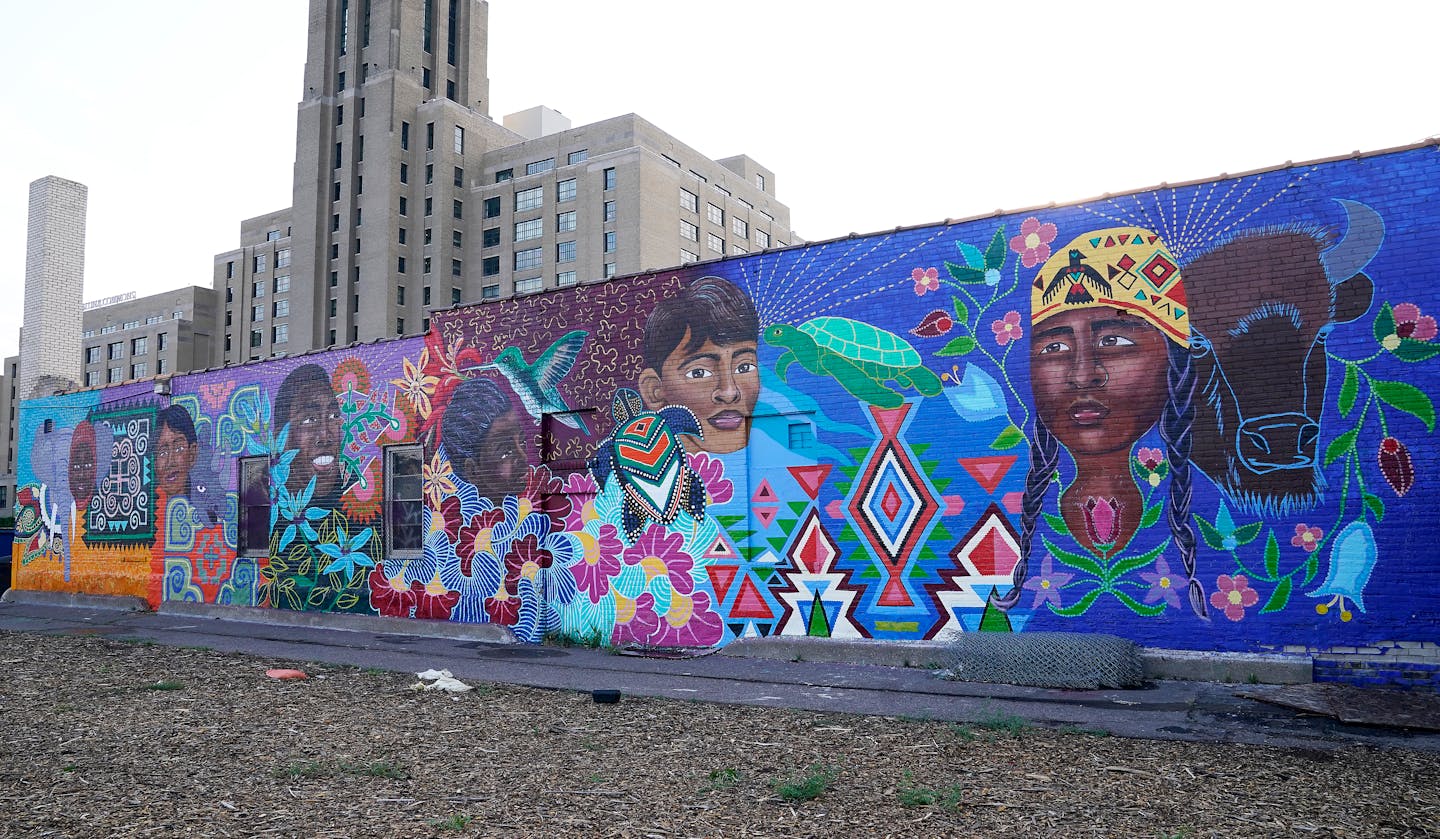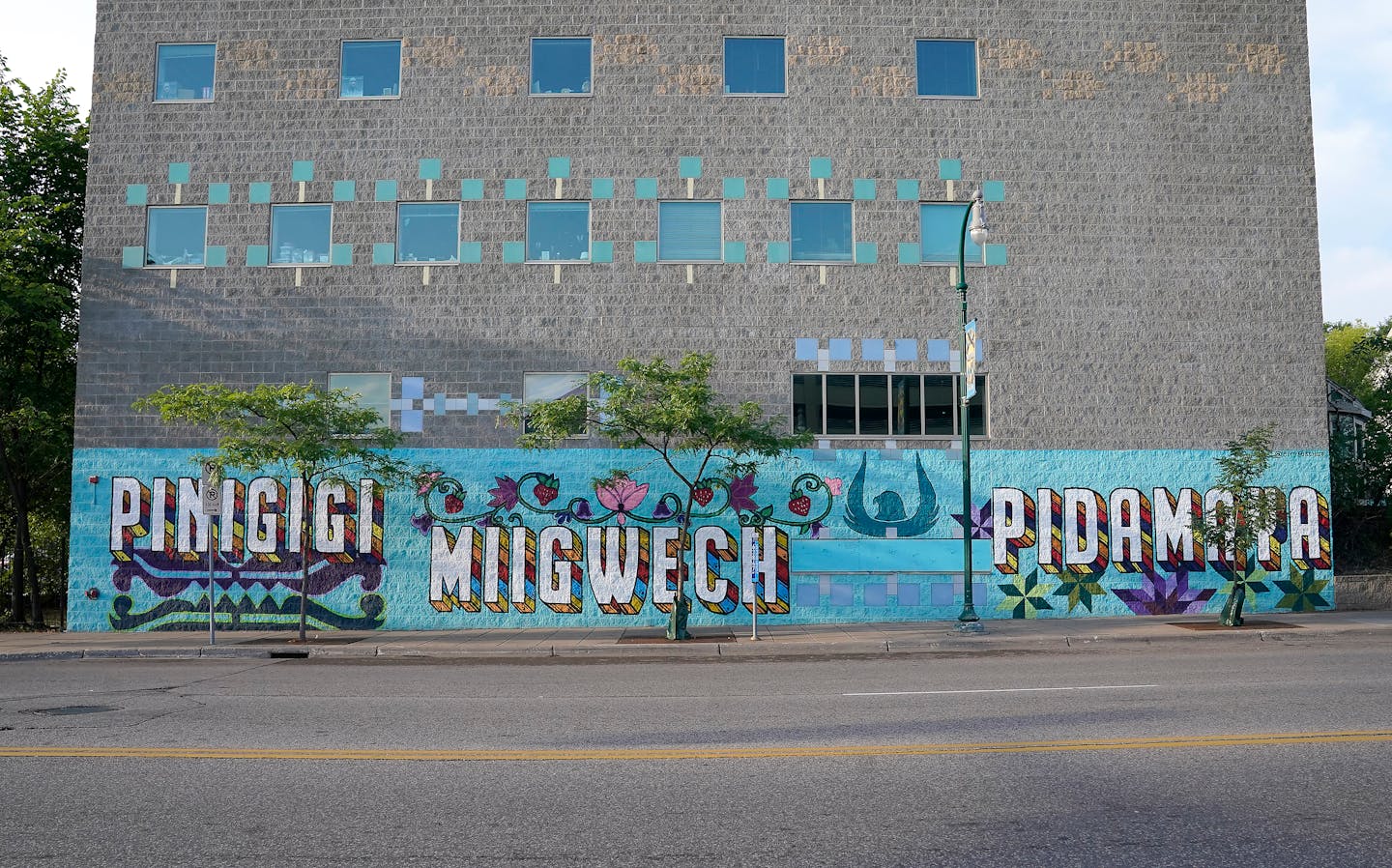he graffiti that marred the walls of Lake Street had become too much.
This is a street that should be celebrated: for its diversity, for serving as an economic engine for communities new and old, for enhancing the lives of south Minneapolis. The gang tags and other graffiti ruined that image, business owners felt.
And when they tried to clear it away a few years back, it would return the next day.
The graffiti is "very expensive, very costly, very ugly," said Louise Matson, executive director of the Division of Indian Work, headquartered on Lake Street.
"We were repainting on average about once a month," said Mauro Madrigal, owner of La Mexicana Grocery at Lake Street and Bloomington Avenue.
Matson and Madrigal joined other property owners along the street in search of a solution. They settled on more paint — lots of it.
Walk down E. Lake Street now, and you'll see colorful murals showcasing a neighborhood in transformation. Not only from vandalism, but from the economic uncertainty of a pandemic and the scars of the riots that followed the murder of George Floyd.
How it's happening
A collection of businesses, nonprofits and other organizations are supporting the new murals.
Lake Street Council, a local nonprofit, has helped fund numerous murals on E. Lake Street. The colorful displays bring visitors to the area and add a sense of vibrancy.
"We're looking to support projects that bring people together, beautify Lake Street and support the healing of our community," said Charise Canales, manager of placemaking and activation at Lake Street Council.
Many of the latest crop of murals were supported by the organization's We Love Lake Street fund, which has raised money to support local businesses and nonprofits since the riots of 2020.
Other funding has come from private companies like Mortenson Construction, which has invested heavily in the community's rebound from the riots, and groups like the Minneapolis Foundation. Local businesses, like La Mexicana Grocery, also put up their own money.
An effective deterrent
When one business on the street is vandalized, they all feel the impact, the business owners say.
Since the colorful mural went up on the walls of Madrigal's grocery this summer, he said he has not seen any graffiti there — perhaps out of respect for the art. Some of the murals also have graffiti-resistant coatings on them.
At the Division of Indian Work building, not a single tag has appeared on the wall since its mural was completed two years ago, Matson said.
"We know of many people that have businesses on Lake Street. They all say the same thing: graffiti is a huge drawback for the businesses because it tends to keep people away," Madrigal said. "We want to keep Lake Street looking nice."
Not just surface level
Murals are not only aesthetic; they can also build a sense of community by celebrating cultures and histories, say artists who have worked along Lake Street.
"Murals – or any kind of art on the street – makes visible perspectives and experiences that are often unseen or unacknowledged by the dominant culture," said St. Thomas Professor of Art History Heather Shirey, who works on mapping urban artwork.
Murals communicate the area's values to people passing by, said University of Minnesota art history department chair and professor Jenn Marshall.
"A mural is designed to address lots of people at the same time ... It's designed to create community. In a way, it assumes that audience is a community," Marshall said. "That communicates more respect for place, by the community and for the community."
The Star Tribune highlights a few of Lake Street's recent public art pieces:

Jamie Hutt, Star Tribune, Star Tribune
La Mexicana Grocery
"Ancestors," created in 2022. 1522 E. Lake St.
Artist: Copla Murals of Minneapolis
Description: Vivid reds, yellows, blues and blacks serve as the backdrop to two women connected by a river with pieces of mirror amid the paint. As motorists drive by, the water seems to flow from one end of the mural to the other.
History: La Mexicana Grocery has been in business more than 20 years and features two murals on the sides of the building.
The most recent was finished in June. The earlier one was added nearly a decade ago and also features pieces of mirror. Both are meant to bring a sense of the Latino culture to the neighborhood while beautifying the building.
Why? "Hopefully that will make people feel more invited to coming to Lake Street, not just to my business but to all the businesses in the area." — owner Mauro Madrigal

David Joles, Star Tribune, Star Tribune
Hamdi Restaurant
Untitled mural, created in 2021. 818 E. Lake St.
Artist: Melodee Strong
Description: The massive mural spans three walls of the Hamdi Restaurant. Flowers and bright colors cover the exterior bricks.
History: Owner Abdishakur Elmi said he appreciates how the mural helped beautify the business, which has been serving Somalian and East African food for more than 20 years.
Elmi said he asked for flowers in the mural because he finds them beautiful. He likes when people take pictures with the artwork.
Why? "I had no experience in art" before the mural went up. "Now, I know art. I love it." — owner Abdishakur Elmi

David Joles, Star Tribune, Star Tribune
Mercado Central
"Todos Vuelven," created in 2014. 1515 E Lake St.
Artist: Pablo Kalaka
Description: Underneath vividly colored stripes, people stand against a blue background. Orange and green leaves climb upward from the bottom of the piece.
History: Pablo Kalaka, a muralist and illustrator from Venezuela, flew into Minnesota to complete the mural along the Bloomington Avenue side of the building. He wanted to represent the culture and history of the Latino marketplace and Mercado Central's origins. The mural took three months to finish.
Why? "My idea was to say somehow that Mercado Central is a way to come back to our origins. The whole idea of the mural was to paint the people who made the food you're going to eat." — artist Pablo Kalaka

David Joles, Star Tribune, Star Tribune
The Family Partnership
Untitled mural, created in 2021. 1527 E Lake St.
Artists: Thomasina TopBear, Molly Miskitoos Henning, Charles Garcia, Joy Spika, Rony Lopez, Simone Tincher and Gala Ingram
Description: The 54-foot-high and 16-foot-wide mural on the Building for Better Futures resource center is covered in bright colors with butterflies and flowers. Different cultures are represented in depictions of traditional clothing and king protea, the national flower of Somalia.
History: The mural is a celebration and reflection of the strength of families in the neighborhood, said Family Partnership spokesperson Karen Smith.
The mural took a year to plan, said lead mural artist Thomasina TopBear. The mural highlights the individuality of the artists, like the "whimsical style" of the faces done by mural artist Joy Spika.
Why? "It's powerful for children. It's powerful for families. ... The Lake Street corridor is a very diverse corridor, and I think [the mural] reflects the nature of the neighborhood as well." — Karen Smith

David Joles, Star Tribune, Star Tribune
The Division of Indian Work
The DIW Mural, created in 2020. 1001 E Lake St.
Artists: Thomasina TopBear, Holly Miskitoos Henning and other community artists
Description: The mural gives thanks in three indigenous languages. The word "miigwech" — which means "thank you" in Ojibwe — is adorned in flowers and fruit connected by a curvy vine to represent the Anishinaabe or Ojibwe tribal nation.
History: For a long time, Division of Indian Work staff wanted a mural to add something beautiful to the wall and deter graffiti, said Louise Matson, the program's executive director. But there wasn't funding for it.
When an artist approached her last July about painting a mural and offered financial support, Matson excitedly agreed.
Why? "It's a thank you to those people that protected our building [during the riots] and then a thank you to the staff here that in 2020 just really worked the hardest to keep services for our people during the COVID." — DIW Executive Director Louise Matson